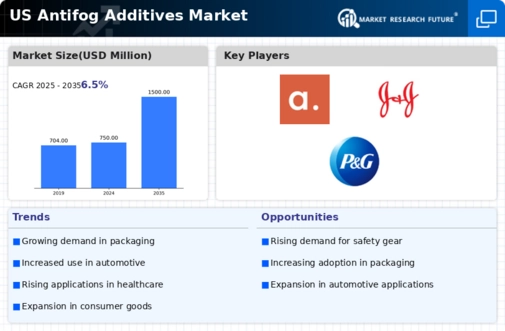The antifog additives market exhibits a dynamic competitive landscape characterized by innovation and strategic positioning among key players. Major companies such as 3M (US), BASF (US), and Eastman Chemical Company (US) are actively shaping the market through their focus on product development and sustainability initiatives. 3M (US) emphasizes innovation in its antifog solutions, leveraging advanced technologies to enhance performance. Meanwhile, BASF (US) adopts a strategy centered on sustainable practices, aiming to reduce environmental impact while meeting customer demands. Eastman Chemical Company (US) focuses on expanding its product portfolio to cater to diverse applications, thereby enhancing its market presence. Collectively, these strategies contribute to a competitive environment that prioritizes technological advancement and sustainability.
Key business tactics within the antifog additives market include localizing manufacturing and optimizing supply chains to enhance efficiency and responsiveness. The market structure appears moderately fragmented, with several players vying for market share. However, the influence of major companies is substantial, as they drive innovation and set industry standards. Their collective efforts in optimizing operations and enhancing product offerings create a competitive atmosphere that encourages continuous improvement and adaptation.
In November 2025, 3M (US) announced the launch of a new line of antifog additives designed specifically for the food packaging industry. This strategic move is significant as it aligns with the growing demand for sustainable packaging solutions, allowing 3M (US) to capture a larger share of this niche market. The introduction of these additives not only enhances product performance but also reinforces the company's commitment to sustainability, positioning it favorably against competitors.
In October 2025, BASF (US) unveiled a partnership with a leading packaging manufacturer to develop innovative antifog solutions tailored for the consumer goods sector. This collaboration is indicative of BASF's (US) strategy to leverage partnerships for technological advancement. By combining expertise, the two companies aim to create products that meet evolving consumer preferences, thereby enhancing their competitive edge in the market.
In September 2025, Eastman Chemical Company (US) expanded its production capacity for antifog additives in response to increasing demand from the automotive sector. This expansion reflects Eastman's (US) proactive approach to market trends and its commitment to meeting customer needs. By increasing production capabilities, the company positions itself to capitalize on growth opportunities while ensuring supply chain reliability.
As of December 2025, current competitive trends in the antifog additives market are increasingly defined by digitalization, sustainability, and the integration of advanced technologies such as AI. Strategic alliances are becoming more prevalent, as companies recognize the value of collaboration in driving innovation and enhancing product offerings. Looking ahead, competitive differentiation is likely to evolve, shifting from price-based competition to a focus on innovation, technology, and supply chain reliability. This transition underscores the importance of adaptability and forward-thinking strategies in maintaining a competitive advantage.














Leave a Comment